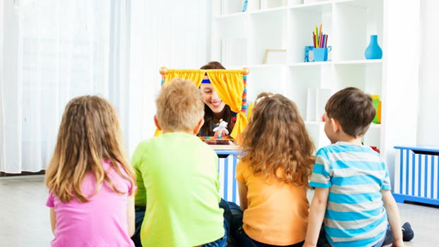
In a world full of digital distractions, it is crucial to find innovative ways to captivate and engage young people. Puppet reading is an enchanting approach that combines the power of storytelling with puppets’ visual appeal. This delightful technique not only sparks children's imagination but also offers numerous advantages for their cognitive, emotional, and social development. In this article, we explore the magical journey of puppet reading and highlight its benefits for children.
Puppet reading breathes life into stories and transforms them into captivating adventures. When children see puppets embodying different characters, they are encouraged to use their imaginations to visualize the narrative unfolding before their eyes. This dynamic interaction stimulates creativity and helps children develop a richer inner world. By engaging with puppets, children are inspired to explore their own creative abilities, fostering imaginative thinking that extends far beyond “Storytime”.

One significant advantage of puppet reading is its positive impact on children's language development. As puppets bring stories to life, they facilitate language acquisition by making the reading experience more engaging and interactive. Children are naturally drawn to characters, prompting them to actively participate in the storytelling process. This active involvement strengthens their vocabulary, comprehension, and expressive language skills as they interact with puppets, answer questions, and engage in dialogue.
Puppet reading is a powerful tool for fostering children’s emotional connections and empathy. Puppets have the ability to express emotions in a tangible and relatable manner, helping young readers connect with characters at a deeper level. Through puppets' interactions and emotional expressions, children learn to understand and empathize with different feelings and perspectives. This emotional connection nurtures social and emotional intelligence, promoting kindness, compassion, and empathy towards others.

The visual and interactive nature of puppet reading stimulates children's memory-retention skills. By incorporating gestures, movements, and voice modulation, puppets can capture children's attention and make the story more memorable. The combination of visual and auditory cues helps to reinforce the story's key details, characters, and plotlines. As a result, children develop stronger recall abilities, which can improve their academic performance and overall cognitive development.
Puppet reading offers an ideal platform for developing essential social skills in children. When participating in puppet-led storytelling sessions, children learn to take turns, listen attentively, and engage in respectful communication. By interacting with the puppets and their peers, children develop their verbal and nonverbal communication skills, learn to express their thoughts and emotions and practice active listening. These social interactions also encourage cooperation, teamwork, and conflict resolution abilities, which are crucial for healthy relationships and future success.
At MAHSA University, you can immerse yourself in our Diploma in Early Childhood Education program, where you can gain hands-on experience with the skills and knowledge needed to excel in the dynamic field of Language, Communication, and Literacy in Early Childhood Education, which is one of our subjects. In addition to theoretical learning, students will learn how to create puppets or other teaching aids to help them become qualified teachers in the future.

 |
MAHSA’s Students of
Diploma in Early Childhood Education learning to make a
puppet stage for a Puppet Reading session |
Words by,
Hidayah Hazirah Hisham
Lecturer, Early Childhood Education
Faculty of Education and Health Science
MAHSA University